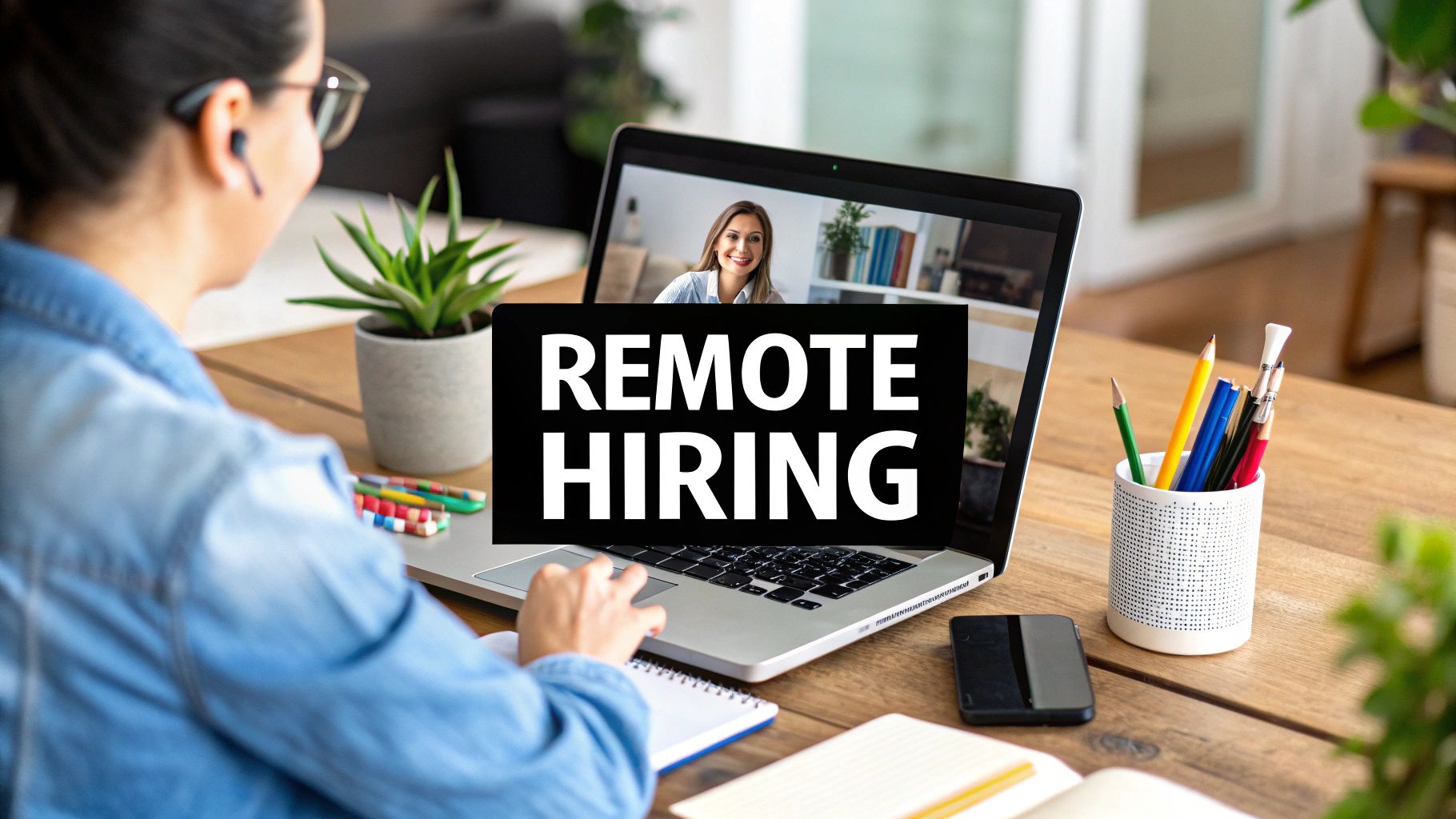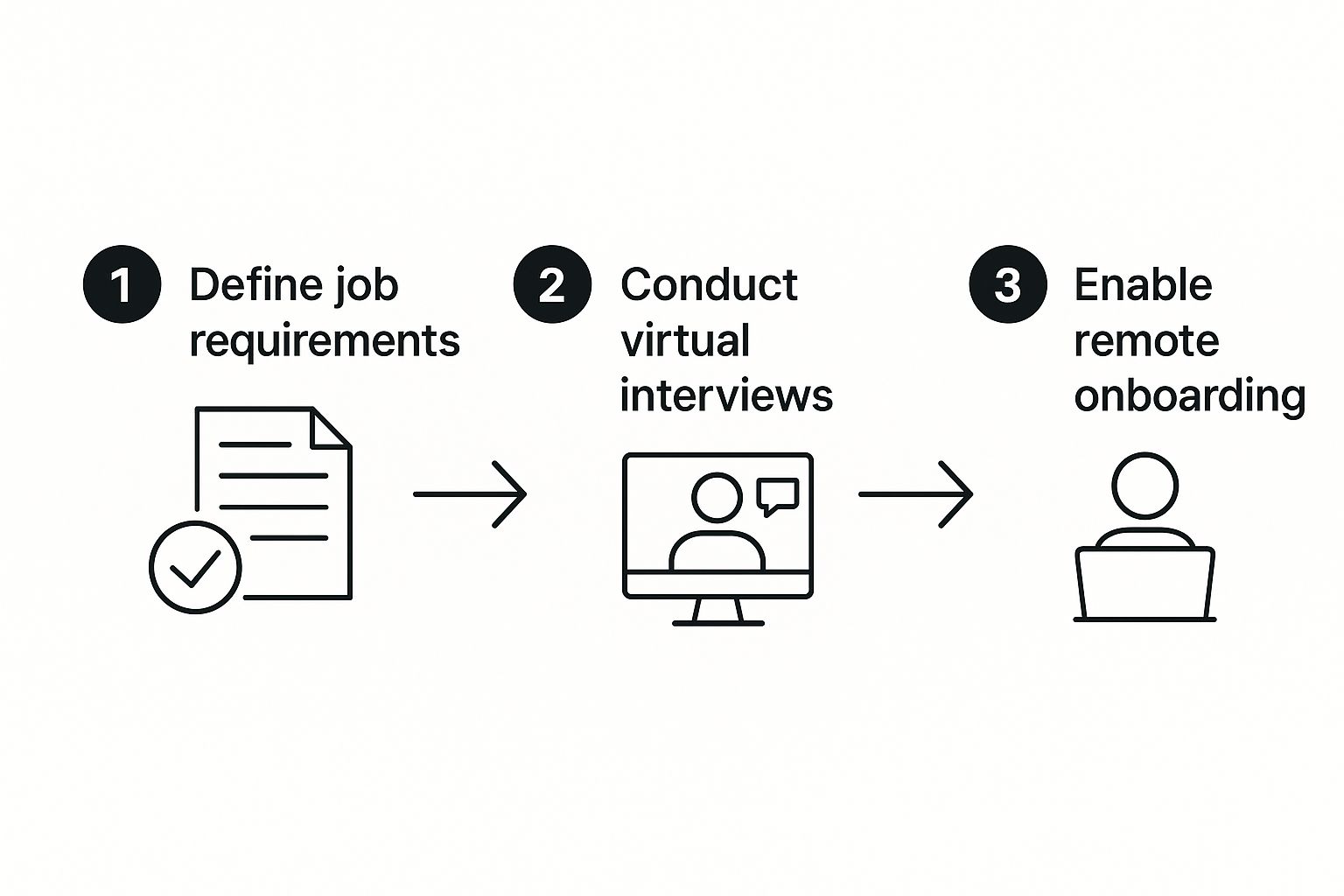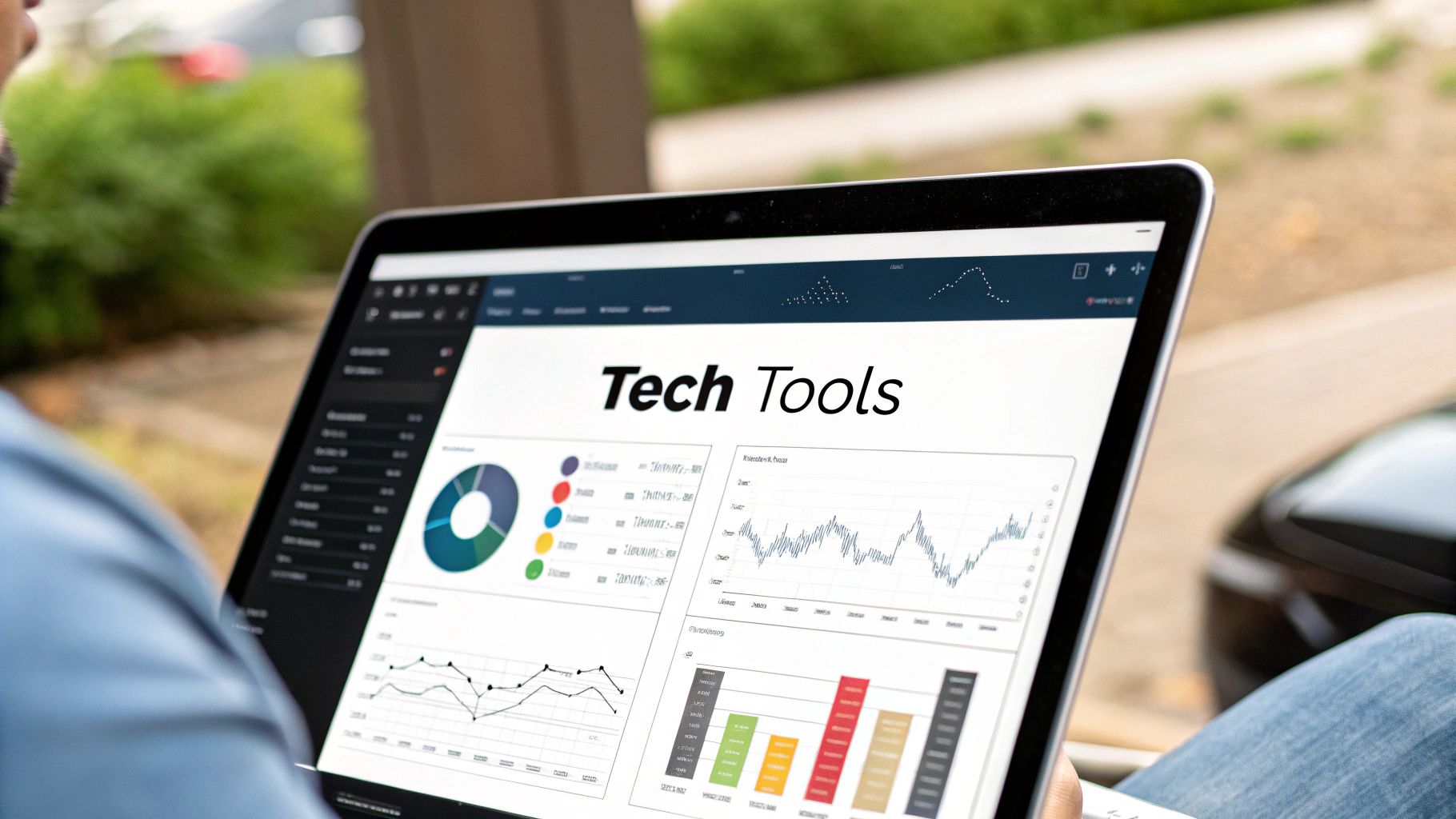Remote hiring isn’t just about conducting interviews over a video call. It’s a complete shift in thinking—a strategic decision to find, screen, interview, and bring new people onto your team without ever meeting them in person. The entire process moves online, allowing companies to hunt for the best talent from anywhere in the world, not just those who live within a commuting distance. This whole approach hinges on using the right digital tools for every single step, from the first application right through to their first day.
In This Article
Why Remote Hiring Is Your New Competitive Edge

What started as a necessity for many has now become a core business strategy for companies serious about growth. Think about it this way: imagine you’re fishing for talent in a small, local pond. You might catch a few good fish, but you’re limited by what’s available in that tiny body of water. Now, picture yourself with access to a vast, global ocean teeming with experts. That’s what a solid remote hiring framework gives you.
When you tear down those geographical walls, you fundamentally change how you build your team.
Unlock a Global Talent Pool
The biggest, most obvious win with remote hiring is getting access to a practically limitless talent pool. Suddenly, you’re not fighting over the same handful of local experts as every other company in your city. Instead, you can find specialists with incredibly niche skills who might live in a different state, or even a different country altogether.
This opens the door to hiring people with unique backgrounds and perspectives that simply aren’t available in your immediate area. For any company looking for highly specialised roles in tech, data science, or creative fields, this kind of access is a game-changer.
“By embracing remote hiring, companies can build a truly global workforce, tapping into diverse skill sets and cultural backgrounds that enrich the organisation and drive innovation.”
Foster Diversity and Inclusion
A fantastic side effect of tapping into a global talent pool is a more diverse workforce. It just happens naturally. Remote hiring breaks down all sorts of barriers—location, socioeconomic status, and even physical mobility. It lets you build teams that are a true reflection of different backgrounds, cultures, and life experiences.
This isn’t just about feeling good; it’s a massive business advantage. Time and again, studies show that diverse teams are more innovative, better at solving complex problems, and far more in tune with a global customer base.
This shift is already well underway here in India. The adoption of remote work has exploded in recent years. As of 2024, over 70% of Indian companies have brought in some form of hybrid or remote work policy, and that number is only expected to climb in 2025. This entire evolution is being supercharged by better internet infrastructure and a new wave of collaboration tools. You can find more insights on how Indian companies are evolving their HR practices on mounttalent.com.
The Two Sides of the Remote Hiring Coin

Jumping into remote hiring is a bit like discovering a whole new continent. On one hand, you gain access to an incredible, worldwide talent pool bursting with skills and fresh perspectives. But on the other, you’re now faced with the challenge of finding the right person in a sea of millions—someone who not only has the skills but truly gets your company’s DNA.
Then there’s the massive opportunity for operational savings. Think about it: fewer desks mean lower rent, slashed utility bills, and less spent on office supplies. This isn’t just about cutting costs; it’s about reallocating those funds to fuel real growth, invest in better tech, or boost employee benefits.
The Culture and Connection Conundrum
Of course, with every opportunity comes a challenge. The money you save on real estate can create a deficit in company culture. When your team only connects through screens, building that genuine sense of camaraderie and belonging takes real, conscious effort.
Those spontaneous water-cooler chats that spark brilliant ideas? They don’t just happen anymore. You have to be intentional about creating virtual spaces for casual talk and setting up clear communication channels to stop teams from drifting into isolated silos.
Remote hiring isn’t just a policy change; it’s a complete rethink of how we build trust, measure success, and create a unified team spirit without the physical anchor of an office.
This shift is already making huge waves across India. By 2025, it’s estimated that somewhere between 60 to 90 million Indians will be working remotely, a massive slice of the entire workforce. Backed by government pushes like Digital India, this trend is creating new economic pathways and employment models that companies need to get ahead of. You can dive deeper into the financial impact of remote work in India on vitt.overleveraged.in.
Tackling the Legal and Logistical Labyrinth
Another major hurdle is the tangled web of logistics and legal red tape. Hiring someone from another state—let alone another country—opens up a Pandora’s box of rules and regulations you’d never encounter with a local employee.
You’ll need to get your head around:
- Tax Compliance: Making sure you’re following the tax laws where your employee lives, not just where your office is.
- Employment Law: Labour laws can be wildly different from one region to another, and you need to comply with them all.
- Payroll and Benefits: How do you handle salaries and benefits across different currencies and legal systems?
- Data Security: Protecting sensitive company data becomes paramount when it’s being accessed from countless personal networks.
Getting this right requires serious planning and, often, specialised help. To lay it all out, let’s look at the pros and cons side-by-side.
Remote Hiring Opportunities vs Obstacles
Every major business decision involves weighing the good against the bad. Here’s a straightforward breakdown of what you stand to gain with remote hiring versus the challenges you’ll need to prepare for.
| Benefit | Potential Challenge |
|---|---|
| Access to a global, diverse talent pool. | Difficulty in assessing cultural fit virtually. |
| Significant reduction in operational costs. | Challenges in maintaining team cohesion and culture. |
| Increased employee satisfaction and retention. | Navigating complex cross-border legal and tax rules. |
| Greater business agility and resilience. | Ensuring everyone has equitable access to tools. |
By looking at both sides of the coin, you can build a remote hiring strategy that’s both ambitious and grounded in reality. The goal is to chase the incredible benefits while being smart enough to get ahead of the risks.
Your Blueprint for a Successful Remote Hiring Process
Making your remote hiring cycle work smoothly isn’t about just copying your old office process and pasting it online. It’s more like designing a completely new machine, one built from the ground up for a distributed world. The best frameworks are repeatable, scalable, and—most importantly—give every single candidate a consistently positive experience, no matter where they are.
The whole point is to create crystal-clear expectations at every single stage. This visual breaks down the core phases of a modern remote hiring strategy, all the way from defining the role to that exciting first day for a new team member.

The real takeaway here is that each step builds on the last, creating a strong foundation to make sure you get the right person for the job. Let’s walk through the actionable steps in this blueprint.
Stage 1: Crafting the Perfect Remote Job Description
Think of your job description as your number one marketing tool. For a remote role, it has to do more than just list out responsibilities. It needs to sell the remote experience and pull in candidates who are genuinely ready to shine in an autonomous environment.
Right off the bat, state clearly that the position is 100% remote. Get specific about any geographical or time-zone needs. For example, if a role needs to sync up with a team in Bengaluru, you should mention the need for significant overlap with IST business hours.
Then, go beyond the standard list of duties and describe what success actually looks like in the role from a remote perspective.
- Define Autonomy: Spell out the level of independence the person will have.
- Communication Tools: Mention the main platforms you live on (like Slack, Asana, or Zoom).
- Cultural Cues: Weave in details about your company’s remote culture, using phrases like “asynchronous-first communication” or “virtual team-building events.”
This kind of detail helps filter out candidates who are still thinking in terms of a traditional office structure and attracts those who get the unique rhythm of remote work.
Stage 2: Designing a Robust Virtual Interview Process
The interview stage is where you have to gauge skills, cultural fit, and remote-readiness without any of the usual in-person cues. This is why a multi-layered approach is so important. A well-designed virtual process helps you swap gut feelings for objective data.
A great remote interview process doesn’t try to replicate an in-person meeting. Instead, it uses technology to create focused, structured interactions that evaluate the specific competencies needed to succeed in a distributed team.
The goal is to get a complete picture of each candidate. A typical process might look something like this:
1. Initial Screening: A quick video call with HR or the hiring manager to cover the basics and see if they align with the company’s mission.
2. Skills-Based Assessment: This is your chance to see them in action. Give them a practical, take-home task that reflects the actual work they’d be doing. For a content writer, maybe a short blog post; for a developer, a coding challenge. This step is non-negotiable for verifying technical skills.
3. Team Panel Interview: A video interview with the people they’d be working with every day. This helps you see their collaborative skills in motion. Focus on behavioural questions, like, “Tell me about a time you managed a project with minimal supervision.”
4. Final Executive Interview: A final chat with a senior leader to make sure there’s a good long-term cultural and strategic fit.
Throughout these stages, pay close attention to how candidates communicate, their proactivity, and how comfortable they seem with the technology you’re using.
Stage 3: Extending the Offer and Onboarding
You’re almost there, but these last steps are just as critical. A compelling remote offer often includes more than just salary. Make sure to highlight the benefits that really support a distributed lifestyle, like a home office stipend, a wellness allowance, or a co-working space membership.
Once they’ve accepted, the baton is passed to onboarding. A smooth, well-organised virtual onboarding is absolutely vital for setting a new hire up for success and making them feel like part of the team from day one. This proactive welcome ensures your new team member is engaged and ready to contribute right from the beginning. For HR professionals looking to fine-tune this stage, exploring a guide to ease the online recruitment process can offer some incredibly valuable and practical strategies.
Building Your Remote Recruitment Tech Stack

If your remote hiring process is the vehicle that gets you to top talent, then your technology stack is the engine powering the whole journey. Having the right tools isn’t just about shifting your process online; it’s about making it smarter, quicker, and more organised for everyone involved. Without a solid tech stack, even the best strategy can stall out, getting bogged down by administrative headaches and a messy candidate experience.
The real goal is to build a seamless workflow where information flows effortlessly from one stage to the next. This isn’t about collecting a random pile of software. It’s about being strategic, choosing tools that integrate well and work together to automate tasks, provide clear data, and free up your team to focus on what they do best—finding great people.
Core Components Of A Modern Tech Stack
To build a truly robust remote hiring system, you need to cover three foundational areas of recruitment. Think of these platforms as the backbone of an efficient, scalable process.
1. Applicant Tracking Systems (ATS) An ATS is basically your central command centre. It’s where every application is stored, every interaction is tracked, and every member of the hiring team can see a candidate’s real-time status. A good ATS automates the mind-numbing admin work, like sorting through hundreds of résumés and scheduling interviews.
2. Video Interview Platforms These go way beyond a simple video call. Dedicated interview platforms are essential for structured, consistent evaluations. Many include features like collaborative note-taking, interview recordings for later review, and seamless scheduling integrations. They help ensure every candidate gets a fair shot and a professional experience.
3. Skills Assessment Software This is where you separate theory from practice. Skills assessment tools let you test a candidate’s actual abilities with job-specific challenges. Whether it’s a coding test for a developer or a writing task for a content marketer, these platforms offer objective, data-backed proof of someone’s competence.
These three pieces work in harmony to give you a complete picture of each applicant, grounded in data rather than just gut feelings.
Making Your Tools Work For You
Just having the software isn’t enough; the magic really happens when these systems talk to each other. A great ATS, for example, should integrate directly with your video interviewing and skills assessment tools. This connection allows candidate data to move automatically between platforms, which means no more manual data entry and a much lower risk of human error.
Imagine this: a candidate passes an initial screening in your ATS, and the system automatically sends them a skills assessment. Once they complete it, the results feed directly back into their profile in the ATS. Just like that, the hiring manager has a complete overview without ever having to switch between dashboards.
A well-integrated tech stack transforms your recruitment process from a series of disconnected steps into a fluid, automated journey. It creates a single source of truth for every candidate, empowering your team to make faster, more informed decisions.
This level of automation and organisation is a game-changer for remote hiring. When your team isn’t buried in admin, they can spend their time building relationships with top candidates and making truly strategic hiring decisions. Seeing how a comprehensive recruitment platform eases digital hiring can offer a clearer picture of how these integrated systems drive success.
Building the right tech stack doesn’t just support your remote hiring strategy—it elevates it. By carefully selecting and integrating the right tools, you build a powerful, efficient engine that consistently attracts and identifies the best talent, no matter where in the world they might be.
A modern hiring process relies on a suite of tools working together. Here’s a quick look at the essential software categories you should consider for your remote hiring toolkit.
| Tool Category | Primary Function | Example Tools |
|---|---|---|
| Applicant Tracking System (ATS) | Manages the entire recruitment pipeline from application to hire. | Greenhouse, Lever, Workable |
| Video Interviewing | Conducts live or asynchronous video interviews for remote screening. | HireVue, Spark Hire, VidCruiter |
| Skills Assessment | Provides objective tests to evaluate technical or soft skills. | HackerRank, TestGorilla, Codility |
| Communication & Collaboration | Facilitates internal team communication and candidate messaging. | Slack, Microsoft Teams, Zoom |
| Onboarding Software | Automates paperwork and streamlines the new hire integration process. | BambooHR, Deel, Rippling |
Each category plays a vital role in creating a smooth and effective remote hiring experience for both your team and your future employees.
Creating a Thriving Remote Team Culture
Nailing the remote hiring process and bringing exceptional talent on board is a huge win, but it’s really just the first step. The real test is creating a vibrant, connected culture that makes those talented people want to stay and produce their best work. Without a shared office, culture doesn’t just happen—it has to be built, intentionally, from the very first hello.
Think of a strong remote culture as the invisible architecture of your company. It provides the support, connection, and shared purpose that push back against the isolation people often feel in distributed teams. This isn’t built on grand, one-off gestures, but on the small, thoughtful things you do every single day to make your team feel seen, valued, and part of the mission.
Designing a Memorable Virtual Onboarding
The journey from candidate to team member hits its peak during onboarding. This first experience sets the stage for everything that follows. A clunky, impersonal process can leave a new hire feeling disconnected and second-guessing their decision. But a well-planned virtual welcome makes them feel like a vital part of the team from day one.
The goal here is to go way beyond just setting up software and filling out forms. A truly great remote onboarding is a curated journey.
- Create a Welcome Kit: Nothing makes a new job feel real like a physical package. Send them some company swag, their new laptop, and a handwritten welcome note.
- Assign an Onboarding Buddy: Pair them up with a seasoned team member who isn’t their direct manager. This gives them a friendly face and a safe person to ask all the “silly” questions they might be nervous to ask their boss.
- Structure the First Week: Don’t leave them guessing. Lay out a clear schedule with introductory meetings, key training sessions, and even some casual social calls.
Getting this critical period right is non-negotiable. For more ideas, you can check out our guide on how to deliver a smooth employee onboarding experience.
Fostering Communication and Connection
Once your new hire is settled in, the focus shifts to keeping them engaged and building real team cohesion for the long haul. In a remote setup, you have to be deliberate about creating space for both professional collaboration and genuine personal connection. This is where clear communication rules are an absolute must.
Decide which tools are for what—maybe Slack for quick chats, email for formal announcements, and video calls for deep-dive discussions. This simple clarity cuts down on confusion and makes working across different time zones much smoother.
Building a remote culture is about translating the best parts of in-office collaboration—spontaneity, trust, and shared understanding—into a digital-first environment. It requires deliberate effort to create spaces for both focused work and genuine human connection.
This effort is more critical now than ever. Workforce engagement in India has been on a worrying slide. Projections show that by 2025, only 19% of the workforce will feel engaged, a drop from 24% in 2024. That kind of trend can seriously damage productivity and retention, making proactive culture-building a business imperative. The advice for companies is clear: focus on flexibility and human connection to turn this around. You can find more details on the decline in workforce engagement on adp.com.
Beyond work tasks, make room for the informal chats that build real relationships. Set up virtual coffee breaks, play some online team-building games, or host “show and tell” sessions where people can share their hobbies. It’s these small, consistent efforts that weave together the social fabric, turning a group of individuals into a tight-knit, high-performing team.
Common Questions About Remote Hiring Answered
Even with all its upsides, the idea of hiring someone you’ve never met in person can still feel a bit daunting. As a leader, you’re likely wrestling with some big questions. How do you maintain your company’s unique culture? How do you stay on the right side of the law? How do you keep everyone productive?
Let’s break down some of the most common hurdles and clear the air.
One of the first things leaders ask is how to gauge cultural fit without ever shaking a candidate’s hand. It’s a valid concern. How can you tell if someone will really click with your team’s values just by looking at them through a screen? The secret is to be deliberate.
Instead of just going with your gut feeling from a friendly chat, you need to structure your interviews to specifically test for your core values. Ask behavioural questions that push candidates to share real stories about how they’ve handled collaboration, managed their autonomy, or solved tough problems in the past. This changes the game from a subjective “vibe check” to gathering actual evidence of whether they’ll align with your culture.
Navigating International Complexities
Hiring from around the globe opens up a whole new set of questions, especially around the legal and compliance side of things. The rules for employment, taxes, and benefits can be wildly different from one country to the next, creating a real minefield if you’re not prepared. So, what are the biggest tripwires?
- Misclassifying Employees: Getting it wrong and treating an employee like an independent contractor can land you in hot water with some serious financial penalties.
- Ignoring Local Labour Laws: Every country has its own rules for mandatory leave, notice periods, and termination. Overlooking these is a common—and very expensive—mistake.
- Navigating Payroll and Taxes: Juggling different currencies, tax withholding rules, and social security payments requires specialised expertise.
The smartest way to hire internationally? Don’t try to do it all yourself. Partnering with an Employer of Record (EOR) service means they handle all the legal headaches. This lets you bring on the best talent from anywhere in the world without having to set up your own legal entity in every country.
Finally, a question that’s always top of mind for leaders: how do you ensure your remote team is accountable and performing at a high level? The answer is to shift your mindset from watching what people are doing to measuring what they achieve.
Set crystal-clear expectations from the get-go. Define specific key performance indicators (KPIs) so everyone knows what success looks like, and establish a regular rhythm for check-ins. It’s about trusting your team to deliver results and giving them the freedom to manage their own time to get there.
At Taggd, we specialise in building high-performing remote teams by handling the entire recruitment lifecycle for you. Discover how our expertise can help you hire the best talent, anywhere in the world.
 />
/>





